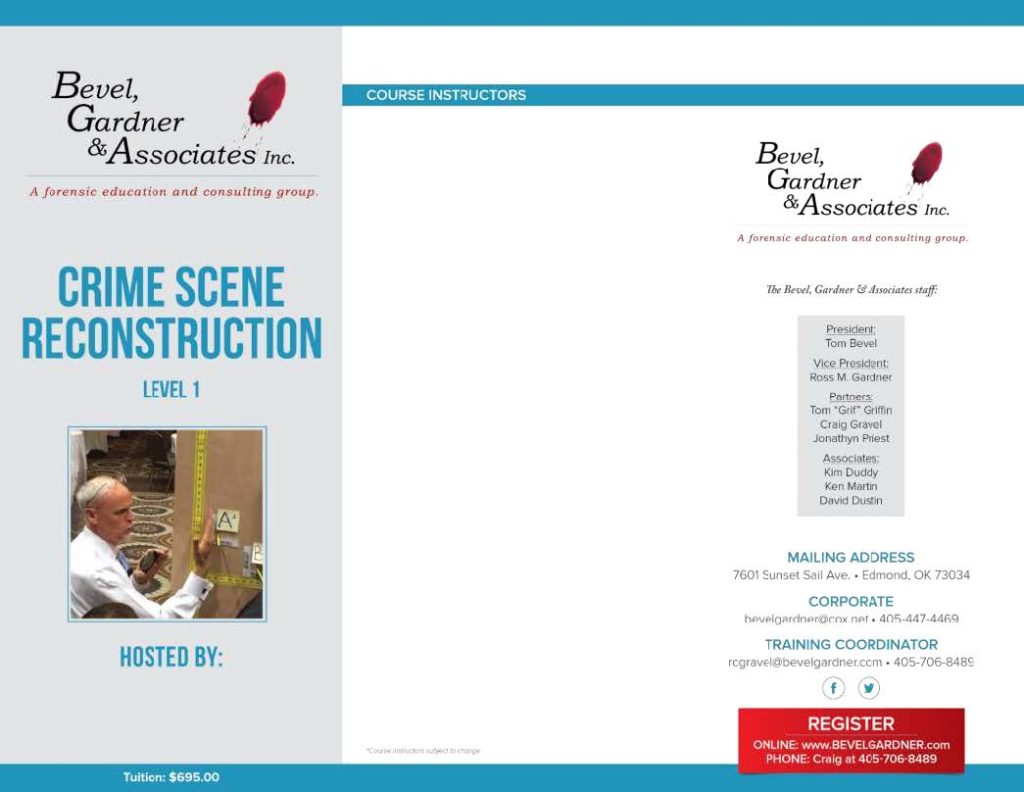

Crime Scene Reconstruction I Course
Class Schedule
Purpose: A course of instruction designed for investigators, crime scene technicians, forensic technicians, and others involved in criminal and medical-legal investigations and crime scene analysis. The course is intended to develop a fundamental knowledge of appropriate hypothesis development and testing procedures and provide an objective form of defining the events associated with a complex crime (Event Analysis). The course syllabus is not intended to create an “instant” expert. This course is not a crime scene processing course.
Course Objectives: Upon completion of the course the student should:
Demonstrate knowledge of the development, history and advancement of crime scene analysis.
Identify the steps of scientific method.
Identify the seven steps of the methodology used in crime scene analysis.
Demonstrate the ability to develop a hypothesis in a written format and set an objective foundation for any ultimate conclusion.
Demonstrate the ability to objectively flow chart an incident, distinguishing relative chronology from absolute chronology.
Demonstrate an ability to evaluate a complex crime scene.
Day One
0800 – 0900 Registration and Introduction.
0900 – 1000 History of Crime Scene Reconstruction. Lecture on the history of crime scene reconstruction and analysis.
1000 – 1130 Introduction to Crime Scene Analysis. Lecture outlining the basic objectives and purpose behind crime scene analysis and reconstruction.
1300 – 1430 Fundamental Aspects of CSR. A lecture outlining the theory and principles behind CSR and the use of basic scientific method to resolve issues encountered in complex crime scenes.
.
1430 – 1530 7 Step Event Analysis Methodology. A lecture introducing the 7 step Event Analysis methodology used to define event segments and their sequence for an incident.
1530 – 1630 Hess Case Presentation
Day Two
Appendix A
CSR I
Appendix A CSR I 2
0800 – 1000 Worksheet Introduction and Event Segment Worksheet Practical. Lecture on the use of worksheets and a group practical using the Event Segment Worksheet.
1000 – 1130 Worksheet Practical – Hines Case
1230 – 1430 Wuertz Case Presentation
1430 – 1500 Direct/Circumstantial Practical. A practical involving the Wuertz case presentation, requiring students to separate objective data from subjective data.
1500 – 1630 Flow Charting. A lecture outlining the use of flow charts to establish the relative chronology of an event. This is followed by a practical involving the previous case presentation.
Day Three
0800 – 1000 Routier Case Presentation. A multi-victim homicide crime scene is presented followed by a discussion of the use of crime scene analysis in resolving specific scene issues.
1100 – 1530 Case Practical. Each student independently develops a conclusion and creates a written foundation for actual case related crime scene issues, which are then discussed as a class. (Two to three practical scenes as time permits).
1530 – 1630 Report Writing and Demonstrative Evidence. A lecture outlining the basic elements of the crime scene analysis report and the use of demonstrative evidence to support the conclusions.
Day Four
0800 – 1700 Day Four Practical. This is a 1 ½ day group practical in which students evaluate all of the case documentation from a complex crime scene (2 victims, 2 suspects, four weapons) and attempt to resolve two specific investigative questions and create a flow chart of the event.
Appendix A
CSR I
Appendix A CSR I 3
Day Five
0800 – 1200 Day Four Practical continues.
1300 – 1600 Group Presentations. Each student group presents their conclusions from the case and explains their flow chart. They then defend their conclusions in front of the instructors and class.